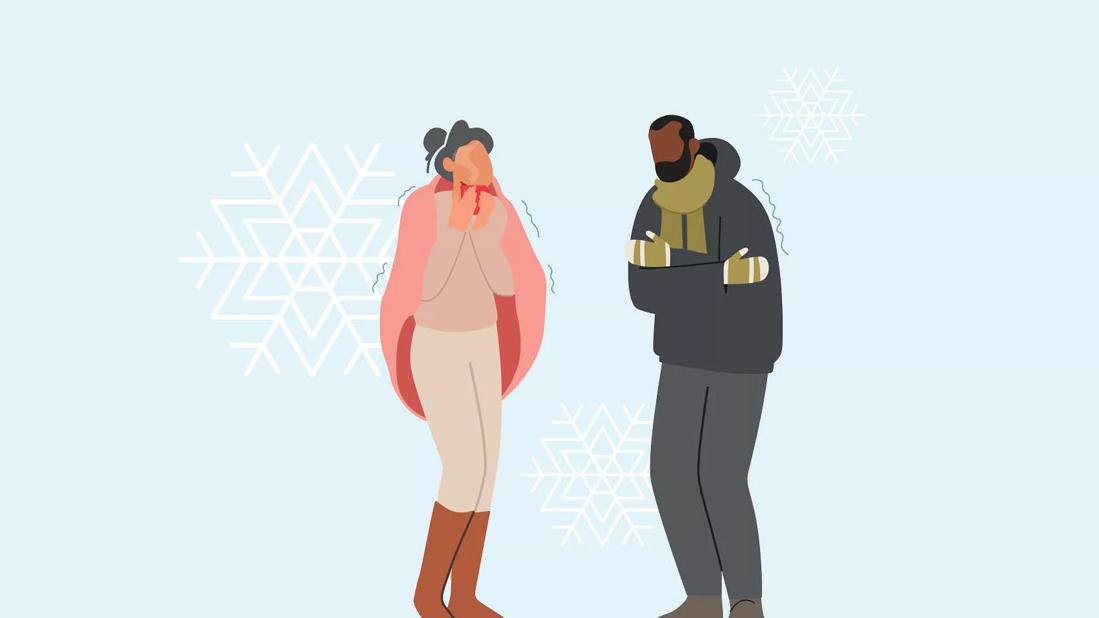The flu, RSV, COVID-19, pneumonia and more typically circulate during cold weather months

‘Tis the season for sharing … cold germs, flu viruses, stomach bugs and more. Cold weather months capture that magical time when your kid brings home a plethora of germs from school or daycare, while your sneezy coworker insists on coming in for a meeting instead of staying home.
Advertisement
Cleveland Clinic is a non-profit academic medical center. Advertising on our site helps support our mission. We do not endorse non-Cleveland Clinic products or services. Policy
This winter season could be another doozy, as numerous respiratory viruses like the respiratory syncytial virus (RSV) surge alongside the flu and COVID-19 (what medical experts have dubbed “flurona”). Can you dodge all these infections? And if you get sick, how long should you expect to be sidelined before you return to regularly scheduled programming?
Family physician Matthew Goldman, MD, explains how to stay safe this winter season, along with how to handle 10 of the most common winter illnesses.
“Illnesses are more common in the winter because contaminated respiratory droplets travel more easily in dry air when an ill person coughs or sneezes,” explains Dr. Goldman. “Plus, people tend to gather indoors when it’s cold outside (and for the holidays), making it easier for germs to spread from person to person.”
We also know that when you catch an illness, symptoms don’t always pop up right away. It could take up to a few days or a week for symptoms of a winter illness to appear depending on which virus you catch or germs you come into contact with and the strength of your immune system. Even though you might not feel sick, you’re still infected during this early incubation period — and you’re likely contagious and able to pass your infection on to others.
Advertisement
“You’re usually most contagious two to three days after you’re infected, but you can infect others for two weeks or longer while recovering from an illness,” reinforces Dr. Goldman.
If you or your child are sick with any illness, you can avoid spreading viruses to others by following these steps:
So, what’s circulating right now? And what should you know if you get sick? Dr. Goldman breaks down the top 10 winter illnesses you can catch during respiratory season:
With more than 200 different cold viruses (rhinoviruses) in circulation, it’s no wonder that most adults catch colds two or three times a year. Kids — with their germy hands, phlegmy coughs and (lack of) sneeze-covering skills — get sick even more frequently.
Cold viruses linger, and you can pass the virus to others for up to two weeks. You and your child are contagious during the symptom-free incubation period. But you’re most likely to infect others when cold symptoms are at their worst — usually around day three of feeling lousy.
“For relief from a cold, staying hydrated is key. Drinking warm liquids like tea can be soothing for a sore throat and congestion, and small changes can make a big difference when you have a cold,” says Dr. Goldman. “Consider using a humidifier in your room to add moisture to the air to help loosen congestion or gargle with warm salt water to relieve a sore throat.”
Flu season runs from October to May, but it’s possible to get sick with an influenza virus any time of the year. The flu sickens millions in the U.S. every year and could lead to potential hospitalization or death. The flu vaccine is the best way to protect yourself and your family from this highly contagious virus. Each year, a new vaccine is rolled out to protect you against current variants of the flu.
By the time you start showing flu symptoms, you’ve probably already given the virus to at least one other person. That’s because you’re contagious before you know you’re sick. The flu is contagious for a week or longer after you first have symptoms.
Advertisement
COVID-19 spreads easily and peaks during respiratory season just like the flu and RSV. Because of this, we now have an annual updated COVID-19 vaccine that functions just like the annual flu vaccine: It protects you and your loved ones from the most dangerous circulating variants of COVID-19.
While you can still get COVID-19 even after you’ve been vaccinated, you’re likely to experience less severe symptoms and you’re less at risk of hospitalization.
If you get infected with COVID-19, you’re more likely to infect others with the virus one to two days before symptoms appear and two to three days after you start feeling unwell. How long you’re contagious can also depend on the severity of your illness. If you have:
“Once your symptoms have significantly improved or resolved, and it’s been at least five days since the onset of symptoms, you can generally be around others,” says Dr. Goldman.
“However, it’s prudent to wear a mask in public spaces or when close to vulnerable individuals for at least 10 days, to minimize the risk of transmitting the infection. If you’re symptom-free and it’s been more than 10 days since your symptoms first appeared, it’s typically safe to resume normal activities without a mask.”
Advertisement
In adults and children who are otherwise healthy, RSV typically causes mild symptoms similar to the common cold. But this respiratory infection can cause potentially life-threatening bronchiolitis and pneumonia in infants, adults who are older and people with weakened immune systems.
Every year, RSV infections in children lead to 58,000 to 85,000 hospitalizations, and now, we’re seeing around 177,000 adults 60 and older be hospitalized with this virus, too. To help protect these populations, we’re now rolling out an RSV vaccine for children and older adults.
If you or your child get infected with RSV, you can be contagious for a couple of days before symptoms appear and up to eight days afterward. But infants who are infected and people with weak immune systems may be contagious for up to four weeks, even when they no longer have symptoms.
The viruses that cause colds, flu and COVID-19 can all lead to bronchitis if they’re left untreated or if their symptoms are severe enough. Also known as a chest cold, bronchitis causes the airways to your lungs to swell and fill with mucus. The most common symptom is a chronic cough that lasts three weeks or longer. Bronchitis isn’t contagious. But the cold, flu or other virus that led to bronchitis is, so you still need to take precautions to prevent infecting others.
Advertisement
Bacteria — as well as the viruses that cause COVID-19 and RSV — can cause pneumonia. Both viral and bacterial pneumonia are contagious, but not everyone who’s exposed gets sick.
Children younger than 2, adults over 65 and people with weakened immune systems should get the pneumococcal (pneumonia) vaccine to prevent severe complications. These populations specifically are at increased risk for severe symptoms, and even death, as a result of pneumonia.
If you have viral pneumonia, you’re contagious until your fever breaks and when you’re fever-free for several days.
If you have bacterial pneumonia, you’re contagious until you’ve taken at least two days of antibiotics and no longer have a fever.
Bacteria, as well as viruses that cause colds and COVID-19, can cause pink eye. This eye infection swells your blood vessels in the tissues (conjunctiva) that line your eyelids and outer eye. Your swollen blood vessels make the white part of your infected eye look pink.
You can spread viral pink eye very easily during the incubation period and while you have symptoms. Bacterial pink eye is contagious until you’ve taken antibiotics for at least 24 hours — or until the symptoms go away. For this reason, it’s important that if you have pink eye you avoid touching your face, your eyes and other surfaces as much as possible before washing your hands.
Colds and seasonal allergies can cause sinus infections. Also known as acute sinusitis, this infection occurs when your sinuses, which make mucus, fill with fluids. Bacteria sometimes grow in this mucus, causing bacterial sinusitis. A bacterial sinus infection isn’t contagious, but you can spread the cold that caused the sinus infection to others.
“To alleviate the discomfort of sinus pressure from an infection, I recommend regular saline nasal irrigation. This simple technique helps clear nasal passages, reduce congestion, and ease pressure. It’s a safe and effective way to lessen the symptoms and promote sinus drainage,” advises Dr. Goldman.
“Applying a warm, moist cloth over your sinuses several times a day can also be beneficial. The warmth helps open the nasal passages, reduces the pressure, and provides relief from pain.”
Colds and other viruses tend to cause sore throats. But it’s highly contagious group A streptococcus (strep) bacteria that causes strep throat.
This bacterial infection inflames the throat and tonsils, making it painful to swallow. You or your child may also have a fever and swollen lymph nodes. Left untreated, some children with strep throat will develop a bumpy red rash known as scarlet fever. If you or your child get strep throat, you’re contagious until the fever is gone and you’ve taken antibiotics for at least 12 hours.
Norovirus is a stomach bug that causes diarrhea, vomiting and stomach cramps. Some people call it a “stomach flu”— but a flu strain doesn’t actually cause this illness. Still, noroviruses (there are many types) are highly contagious and difficult to kill. Noroviruses can linger for weeks on surfaces like countertops and doorknobs, too.
You’re most contagious when you’re throwing up, experiencing diarrhea or in the few days after symptoms ease. Unfortunately, you can infect others for two weeks or longer, even when you feel better.
Depending on the illness, you or your child may need treatments like antibiotics or antivirals. If any of the following symptoms occur, you should make an appointment with a healthcare provider:
With some preventive measures (vaccinate!), plenty of soap and water, and lots of common sense (don’t be the sneezy colleague!), we can all work together to weather the sick season better.
Learn more about our editorial process.
Advertisement

Enteroviruses are often to blame for summer colds, leading to a runny nose, sore throat and digestive symptoms

Stress and unhealthy habits can lead to more colds, but taking some precautions may help you stay well

On their own, honey can help soothe a sore throat and garlic has immunity-boosting properties, but you don’t need to go the fermented route

Symptoms can overlap and be hard to distinguish, but there are some telltale differences

The advice dates to 1574, but it doesn’t quite meet modern medical guidelines

Ultimately, the best medicine for a cold is time, fluids and rest

From garlic to elderberry, here’s how not to get rid of a cold

You can’t cure it, but you can manage the symptoms

If you’re feeling short of breath, sleep can be tough — propping yourself up or sleeping on your side may help

If you fear the unknown or find yourself needing reassurance often, you may identify with this attachment style

If you’re looking to boost your gut health, it’s better to get fiber from whole foods